



-
- Free Word Search




A UPS will supply power to your equipment and prevent major losses in the unlikely event of a power outage or power trouble. There are many different types of UPS available, so how do you choose the one that best suits your needs?
In this article, we will explain everything from basic selection factors such as capacity and backup time to additional selection factors such as "it would be convenient if this function was available."
When selecting a UPS, there are "basic" selection factors for the specifications as well as "additional" selection factors.
Basic
+α Function Edition
The following sections will explain each in detail.
The first thing to do is to clarify the purpose of what you want to protect from power outages and other power problems by installing a UPS. Based on that purpose, you can decide which devices to back up with the UPS.
For example, if you want to protect "data" from "loss" due to power supply problems, you need to back up PCs, servers, network devices, inspection equipment, etc. On the other hand, if you want to protect "products" manufactured in a factory from "defects" caused by power supply problems, you need to back up production equipment and manufacturing lines, etc.
The size and price of a UPS will vary greatly depending on what you want to protect (the device to be backed up), so you first need to clarify this point.
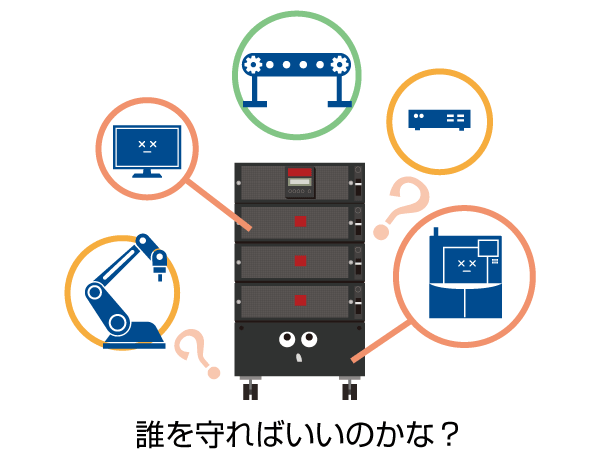
The next thing to decide is the "capacity." In other words, how much power can the UPS supply? Let's look at the terms, units, and selection methods required for capacity selection.
The specification listed in the catalog indicating the capacity of a UPS is the "rated output capacity." Rated output capacity is the amount of power that can be output (supplied) from the UPS, and is listed in the catalog as "Rated output capacity (apparent power/active power): 1kVA/0.8kW."
Here we will explain the unfamiliar unit VA (Volt-Ampere). VA (Volt-Ampere) is a product of V (Volt) and A (Ampere), and is calculated as V (Volt) x A (Current) = VA (Power Capacity). k (Kilo) represents 1,000.
[Example] A 1kVA (1000VA) UPS can back up target devices with a voltage of 100V and a total current value of up to 10A.
The difference between VA (apparent power) and W (active power) is explained in the downloadable document "Understanding the basics of UPS selection!"
Next, check the power consumption of the device to be backed up in the catalog or specifications.
Here are some examples of power consumption for everyday devices to give you an idea of what it is like. Please check the actual power consumption of the device you are backing up.
・PC: 0.35 kVA
・FA PC: 1 kVA
・Server: 2 kVA
・Factory equipment: 20 to 300 kVA
・Conveyor line: 20 kVA
・Production line: 100 kVA
In catalogs and specifications, power consumption may be listed in [W] instead of [VA], or in either [VA] or [W]. If only one is listed, the other is calculated using the [power factor] also listed in the catalog or specifications.
*1 If the power factor is not specified, the power factor will be calculated assuming a maximum of 1.0 (100%).
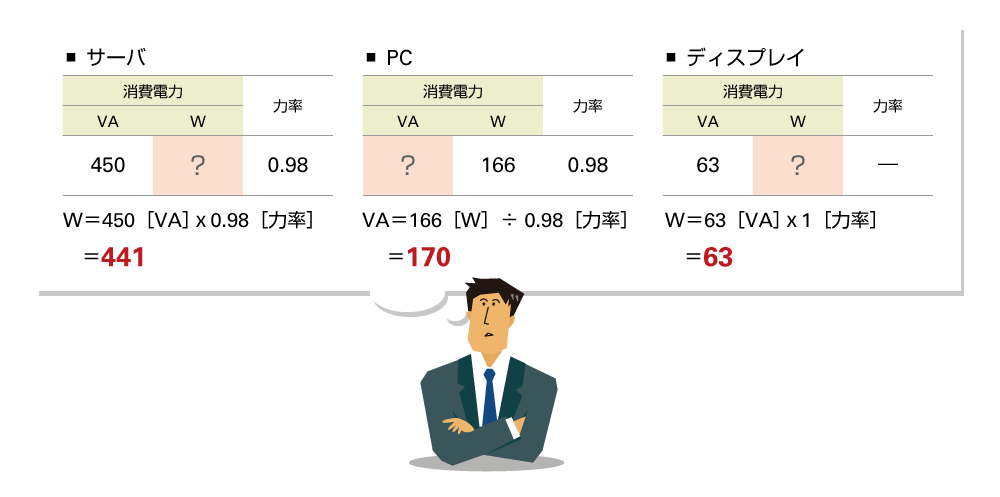
A detailed explanation of power factor is provided in the downloadable document "Understanding the Basics of UPS Selection!"
So far, we have explained the rated output capacity of UPS and the power consumption of the backup target device. Now, based on that, let's choose the rated output capacity of the UPS from an example.
I would like to use a UPS to back up a set of 703 [VA] / 684 [W] information hardware as shown below.
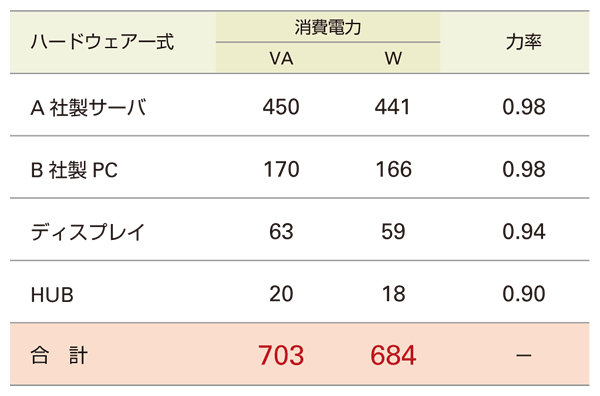
For a UPS to meet this requirement, the rated output capacity [kVA]/[kW] of the UPS explained in 2-1 must exceed the power consumption of the device to be backed up, which is 703 [VA]/684 [W] respectively.
Taking all of this into consideration, we chose our UPS, the E11B 1.0kVA model. Let's compare the capacity of the UPS and the backup target device.
In the above example, we can see that the power consumption of the backup target device is covered by the output capacity of the UPS.
However, when choosing a UPS, it is necessary to choose one with a certain amount of "capacity" that allows for a margin, rather than one that is just at the limit of the power consumption of the device to be backed up. For this reason, I ultimately chose the E11B 1.5kVA model, which is the most recent size.
Now you can select a UPS that will more than cover the power consumption of the devices to be backed up.
The next thing to decide after capacity is the "backup time (retention time)." Let's take a look at how you should choose it.
Backup time is the amount of time that a UPS can supply power when a power outage or other power problem occurs. In the catalog, this is listed in minutes, such as x minutes.
The required backup time varies greatly depending on "how long you need to supply power for, and what you want to do while power is being supplied." Below is an example.
[There was a power outage!]
When selecting a UPS based on backup time, it is necessary to understand the value of "load factor". Load factor is the ratio of the load capacity to the capacity of the UPS. For example, suppose you are trying to back up a device that consumes 2kVA with a UPS with a rated capacity of 10kVA. In that case, the load factor is 2 [kVA] ÷ 10 [kVA] = 20%.
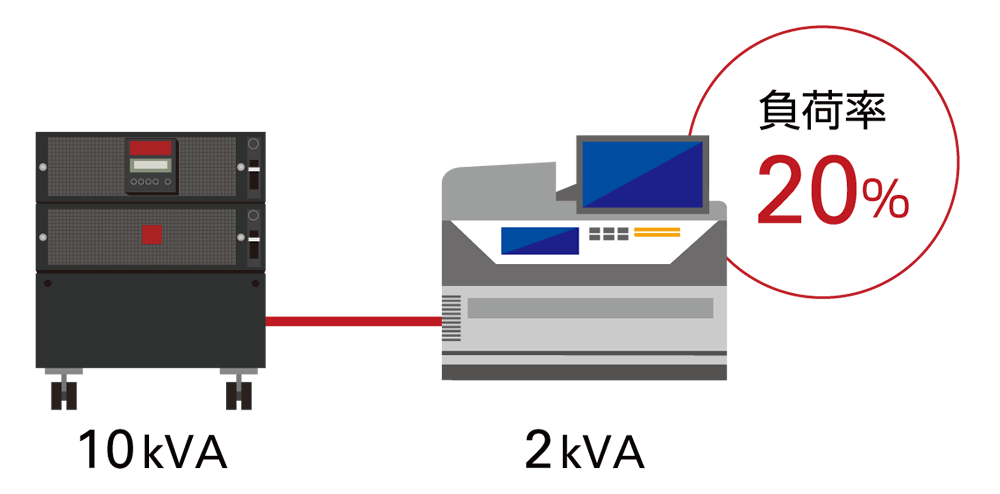
We will explain how to calculate the load factor using the example in 2-3 above. The required backup time is 8 minutes.

Let's say we're going to back up the same hardware set as before with a UPS "E11B1.5kVA model" with an output capacity of 1500VA / 1200W. The UPS load factors are "VA 1500VA > 703VA (47%)" and "W 1200W > 684W (57%)", so we'll use the stricter condition of 57% W. The load factor has now been determined.
Next, we refer to the "Load rate - backup time graph" in the UPS catalog. We can see that in this case, when the load rate is 57%, the backup time is "more than 10 minutes." Therefore, we can determine that the required "8 minutes" of backup time is secured.
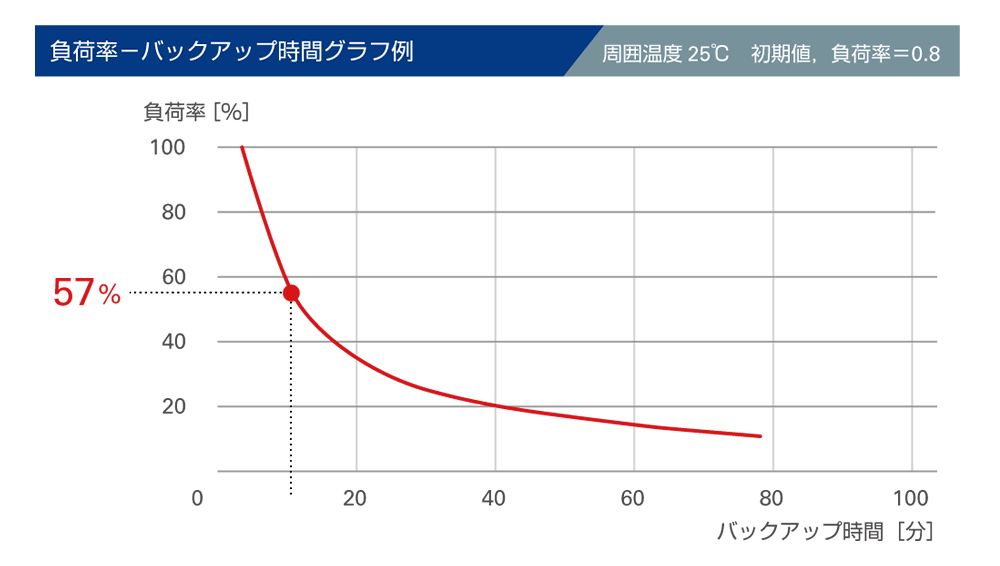
So far, we have explained the most basic points to consider when selecting a UPS: "device to be backed up," "capacity," and "backup time."
Now, we will introduce the specifications that are necessary when selecting a UPS. Be sure to check the catalogs and specifications of the UPS and the backup target device carefully.
The input voltage is the voltage sent from "commercial power source → UPS". The output voltage is the voltage sent from "UPS → backup target device". The input and output are basically the same voltage. They are divided into 100V and 200V systems, which often differ depending on the country, with the 100V system being the mainstream in Japan.
The frequency varies depending on the region where the UPS is used, with 50Hz in eastern Japan and 60Hz in western Japan. Frequencies also vary overseas. When selecting a UPS, be sure to choose one that is compatible with the local frequency.
There are two ways to transmit electricity: "single-phase" and "three-phase." Roughly speaking, "single-phase" is used for household outlets and is often used in small-capacity UPS. On the other hand, "three-phase" is often used for commercial power such as in factories, and medium- to large-capacity UPS are often three-phase.
As you begin to select the specifications, you will also need to check how the equipment will be delivered and installed. Check in advance whether you can secure an installation location, whether the floor is strong enough, and whether there are any problems with the wiring or delivery route to avoid any issues when it comes to delivering the equipment.
So far, we have explained how to choose a UPS based on its capacity and backup time, as well as its specifications. From here on, we will introduce how to choose a UPS based on additional functions that you might want to add.
First, let's talk about the power supply method. Although the names vary depending on the manufacturer, there are several power supply methods for UPS. We will introduce the features of each method in the case of SANYO DENKI.
The advantages are: 1) low cost, 2) relatively small size, and 3) energy efficiency. On the other hand, the disadvantage is that when a power outage occurs, a momentary interruption occurs when supplying power, so some voltage drop and waveform disturbance are unavoidable. This is a power supply method recommended for those who prioritize price and energy saving and are OK with some momentary interruptions.
Details page: What is Passive Standby UPS?
The advantages are that 1) power can be supplied without interruption during a power outage, and 2) there is no distortion of the waveform. On the other hand, the price is relatively high and the power consumption is high. This is a power supply method recommended when "uninterrupted power supply and reliable power supply are more important than cost."
Details page: What is Double Conversion Online UPS?
The "Parallel Processing" combines the best of both the "Passive Standby" and the "Double Conversion Online." It supplies power without interruption during a power outage and can regulate the waveform, while also achieving low power consumption.
Details page: What is Parallel Processing UPS?
There are two types of batteries installed in UPS: lead-acid batteries and lithium-ion batteries. Lead-acid batteries were traditionally the norm, but in recent years they have been increasingly replaced by lithium-ion batteries.
The battery life of a UPS is "2 to 5 years" for conventional lead-acid batteries, but lithium-ion batteries have a long life of "10 years." *2 Not only does the longer life reduce maintenance costs, but it also has many other benefits, such as making the UPS smaller and lighter, and reducing capacity loss due to aging.
*2 Varies depending on usage environment and ambient temperature
Details page: A thorough comparison of UPS lithium-ion batteries and lead-acid batteries!
Finally, we will introduce the LAN Interface Card, an optional feature for those who want to improve the efficiency of UPS maintenance and advance the IoT in their factories.
By installing LAN Interface Card (LAN card) in the UPS and connecting it to the network in the factory, it is now possible to monitor and control multiple UPSs at the same time. Also, if you use a LAN card that supports Modbus communication, and the factory already has "IoT devices using Modbus communication" such as PLCs, you can easily connect the UPS to peripheral devices and monitor them all at once, contributing to the IoT and visualization of the factory.
The information we have explained today, plus more detailed explanations, is summarized in this document.
Please download it and use it!
Supervisor: Dr. Kiyotaka Izumiya, Senior Technical Advisor, Sales Department SANYO DENKI CO., LTD.
Update date: /release date: